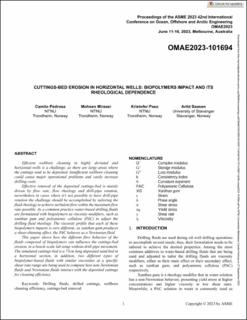Cuttings-Bed Erosion in Horizontal Wells: Biopolymers Impact and its Rheological Dependence
Original version
10.1115/OMAE2023-10169410.1115/OMAE2023-101694
Abstract
Efficient wellbore cleaning in highly deviated and horizontal wells is a challenge, as there are large areas where the cuttings tend to be deposited. Insufficient wellbore cleaning could cause major operational problems and vastly increase drilling costs.
Effective removal of the deposited cuttings-bed is mainly driven by flow rate, flow rheology and drill-pipe rotation, nevertheless in cases where it’s not possible to have drill-pipe rotation the challenge should be accomplished by tailoring the fluid rheology to achieve turbulent flow within the maximum flow rate possible. As a common practice water-based drilling fluids are formulated with biopolymers as viscosity modifiers, such as xanthan gum and polyanionic cellulose (PAC) to adjust the drilling fluid rheology. The viscosity profile that each of these biopolymers imparts is very different, as xanthan gum produces a shear-thinning effect, the PAC behaves as a Newtonian fluid.
This paper shows how the different flow behavior of the fluids composed of biopolymers can influence the cuttings-bed erosion, in a bench-scale lab setup without drill-pipe movement. The simulated cuttings-bed is a 75cm long deposited sand bed in a horizontal section, in addition, two different types of biopolymer-based fluids with similar viscosities at a specific shear rate range are being used to compare how non-Newtonian fluids and Newtonian fluids interact with the deposited cuttings for cleaning efficiency.
